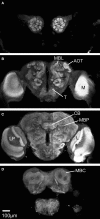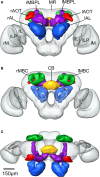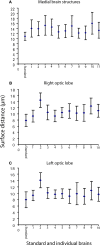Digital, Three-dimensional Average Shaped Atlas of the Heliothis Virescens Brain with Integrated Gustatory and Olfactory Neurons
- PMID: 19949481
- PMCID: PMC2784302
- DOI: 10.3389/neuro.06.014.2009
Digital, Three-dimensional Average Shaped Atlas of the Heliothis Virescens Brain with Integrated Gustatory and Olfactory Neurons
Abstract
We use the moth Heliothis virescens as model organism for studying the neural network involved in chemosensory coding and learning. The constituent neurons are characterised by intracellular recordings combined with staining, resulting in a single neuron identified in each brain preparation. In order to spatially relate the neurons of different preparations a common brain framework was required. We here present an average shaped atlas of the moth brain. It is based on 11 female brain preparations, each stained with a fluorescent synaptic marker and scanned in confocal laser-scanning microscope. Brain neuropils of each preparation were manually reconstructed in the computer software Amira, followed by generating the atlas using the Iterative Shape Average Procedure. To demonstrate the application of the atlas we have registered two olfactory and two gustatory interneurons, as well as the axonal projections of gustatory receptor neurons into the atlas, visualising their spatial relationships. The olfactory interneurons, showing the typical morphology of inner-tract antennal lobe projection neurons, projected in the calyces of the mushroom body and laterally in the protocerebral lobe. The two gustatory interneurons, responding to sucrose and quinine respectively, projected in different areas of the brain. The wide projections of the quinine responding neuron included a lateral area adjacent to the projections of the olfactory interneurons. The sucrose responding neuron was confined to the suboesophageal ganglion with dendritic arborisations overlapping the axonal projections of the gustatory receptor neurons on the proboscis. By serving as a tool for the integration of neurons, the atlas offers visual access to the spatial relationship between the neurons in three dimensions, and thus facilitates the study of neuronal networks in the Heliothis virescens brain. The moth standard brain is accessible at http://www.ntnu.no/biolog/english/neuroscience/brain.
Keywords: insect; neuron; olfaction; taste; three-dimensional reconstruction.
Figures








Similar articles
-
Central gustatory neurons integrate taste quality information from four appendages in the moth Heliothis virescens.J Neurophysiol. 2010 Jun;103(6):2965-81. doi: 10.1152/jn.00985.2009. Epub 2010 Mar 10. J Neurophysiol. 2010. PMID: 20220075
-
Integration of the antennal lobe glomeruli and three projection neurons in the standard brain atlas of the moth heliothis virescens.Front Syst Neurosci. 2010 Feb 12;4:5. doi: 10.3389/neuro.06.005.2010. eCollection 2010. Front Syst Neurosci. 2010. PMID: 20179785 Free PMC article.
-
Two closely located areas in the suboesophageal ganglion and the tritocerebrum receive projections of gustatory receptor neurons located on the antennae and the proboscis in the moth Heliothis virescens.J Comp Neurol. 2006 May 1;496(1):121-34. doi: 10.1002/cne.20908. J Comp Neurol. 2006. PMID: 16528726
-
Three-dimensional average-shape atlas of the honeybee brain and its applications.J Comp Neurol. 2005 Nov 7;492(1):1-19. doi: 10.1002/cne.20644. J Comp Neurol. 2005. PMID: 16175557
-
Anatomical organization of antennal lobe projection neurons in the moth Heliothis virescens.J Comp Neurol. 2007 Feb 1;500(4):658-75. doi: 10.1002/cne.21194. J Comp Neurol. 2007. PMID: 17154270
Cited by
-
Development of a scheme and tools to construct a standard moth brain for neural network simulations.Comput Intell Neurosci. 2012;2012:795291. doi: 10.1155/2012/795291. Epub 2012 Aug 16. Comput Intell Neurosci. 2012. PMID: 22952471 Free PMC article.
-
Application for the Drosophila ventral nerve cord standard in neuronal circuit reconstruction and in-depth analysis of mutant morphology.J Neurogenet. 2010 Sep;24(3):158-67. doi: 10.3109/01677063.2010.489624. J Neurogenet. 2010. PMID: 20615087 Free PMC article.
-
Built to Last: Functional and Structural Mechanisms in the Moth Olfactory Network Mitigate Effects of Neural Injury.Brain Sci. 2021 Apr 5;11(4):462. doi: 10.3390/brainsci11040462. Brain Sci. 2021. PMID: 33916469 Free PMC article.
-
Organization of the parallel antennal-lobe tracts in the moth.J Comp Physiol A Neuroethol Sens Neural Behav Physiol. 2022 Nov;208(5-6):707-721. doi: 10.1007/s00359-022-01566-x. Epub 2022 Sep 16. J Comp Physiol A Neuroethol Sens Neural Behav Physiol. 2022. PMID: 36112200 Free PMC article. Review.
-
Exploring miniature insect brains using micro-CT scanning techniques.Sci Rep. 2016 Feb 24;6:21768. doi: 10.1038/srep21768. Sci Rep. 2016. PMID: 26908205 Free PMC article.
References
-
- Berg B. G., Almaas T. J., Bjaalie J. G., Mustaparta H. (1998). The macroglomerular complex of the antennal lobe in the tobacco budworm moth Heliothis virescens: specified subdivision in four compartments according to information about biologically significant compounds. J. Comp. Physiol. A 183, 669–68210.1007/s003590050290 - DOI
-
- Bräunig P., Pflüger H.-J. (2001). The unpaired median neurons of insects. Adv. In Insect Phys. 28, 185–266
LinkOut - more resources
Full Text Sources
Miscellaneous

